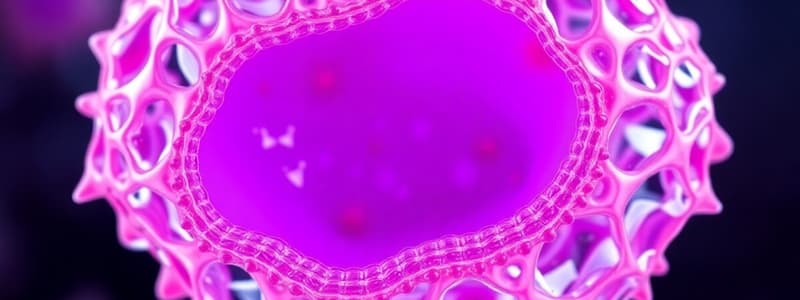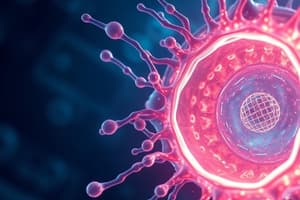Podcast
Questions and Answers
गोल्जी उपकरण का मुख्य कार्य क्या है?
गोल्जी उपकरण का मुख्य कार्य क्या है?
- वेसिकल के माध्यम से सामग्री का परिवहन करना
- ATP उत्पादन करना
- प्रोटीन और लिपिड का संशोधन और पैकेजिंग करना (correct)
- ऊर्जा का भंडारण करना
माइटोकॉंड्रिया की मुख्य विशिष्टता क्या है?
माइटोकॉंड्रिया की मुख्य विशिष्टता क्या है?
- यह कोशिका में अपशिष्ट पदार्थों को तोड़ते हैं
- यह कोशिका के आकार को निर्धारित करते हैं
- यह शाकीय कोशिकाओं में होते हैं
- यह अपनी स्वयं की DNA और राइबोसोम रखते हैं (correct)
लाइसोज़ोम का कार्य क्या है?
लाइसोज़ोम का कार्य क्या है?
- पोषण तत्वों का उत्पादन करना
- कचरे के उत्पादों को संग्रहीत करना
- अपशिष्ट सामग्रियों और विदेशी आक्रमणकारियों को तोड़ना (correct)
- प्रकाश ऊर्जा को अवशोषित करना
साइटोस्केलेटन की विशेषता क्या है?
साइटोस्केलेटन की विशेषता क्या है?
प्रोकैरियोटिक सेल और युकैरियोटिक सेल में क्या अंतर है?
प्रोकैरियोटिक सेल और युकैरियोटिक सेल में क्या अंतर है?
जीवों की कोशिकाओं का मूल संरचनात्मक और कार्यात्मक इकाई क्या है?
जीवों की कोशिकाओं का मूल संरचनात्मक और कार्यात्मक इकाई क्या है?
पौधों की कोशिकाओं में कौन-सी विशेष विशेषताओं होती हैं जो जानवरों की कोशिकाओं में नहीं होतीं?
पौधों की कोशिकाओं में कौन-सी विशेष विशेषताओं होती हैं जो जानवरों की कोशिकाओं में नहीं होतीं?
कोशिका मेम्ब्रेन का मुख्य कार्य क्या है?
कोशिका मेम्ब्रेन का मुख्य कार्य क्या है?
कोशिका की साइट में प्रोटीन संश्लेषण का प्रमुख स्थान क्या है?
कोशिका की साइट में प्रोटीन संश्लेषण का प्रमुख स्थान क्या है?
साइटोप्लाज्म का मुख्य घटक क्या होता है?
साइटोप्लाज्म का मुख्य घटक क्या होता है?
कोशिका भित्ति का मुख्य घटक क्या है?
कोशिका भित्ति का मुख्य घटक क्या है?
न्यूक्लियस में राइबोसोमों का निर्माण किस संरचना में होता है?
न्यूक्लियस में राइबोसोमों का निर्माण किस संरचना में होता है?
कौन सा एन्डोप्लास्मिक रेटिकुलम प्रोटीन संश्लेषण में संलग्न होता है?
कौन सा एन्डोप्लास्मिक रेटिकुलम प्रोटीन संश्लेषण में संलग्न होता है?
Flashcards
कोशिका (Cell)
कोशिका (Cell)
सभी जीवित जीवों की मूलभूत संरचनात्मक और कार्यात्मक इकाई, प्लाज्मा झिल्ली से घिरी होती है और जिसमें कोशिका द्रव्य होता है।
कोशिका झिल्ली (Cell Membrane)
कोशिका झिल्ली (Cell Membrane)
कोशिका की बाहरी परत जो पदार्थों के आवागमन को नियंत्रित करती है।
कोशिका भित्ति (Cell Wall)
कोशिका भित्ति (Cell Wall)
पौधों की कोशिकाओं की एक कठोर बाहरी परत जो संरचनात्मक समर्थन प्रदान करती है।
कोशिका द्रव्य (Cytoplasm)
कोशिका द्रव्य (Cytoplasm)
Signup and view all the flashcards
केन्द्रक (Nucleus)
केन्द्रक (Nucleus)
Signup and view all the flashcards
राइबोसोम (Ribosomes)
राइबोसोम (Ribosomes)
Signup and view all the flashcards
एंडोप्लाज्मिक रेटिकुलम (Endoplasmic Reticulum)
एंडोप्लाज्मिक रेटिकुलम (Endoplasmic Reticulum)
Signup and view all the flashcards
केन्द्रीय रिक्तिका (Central Vacuole)
केन्द्रीय रिक्तिका (Central Vacuole)
Signup and view all the flashcards
गोल्गी तंत्र क्या है?
गोल्गी तंत्र क्या है?
Signup and view all the flashcards
माइटोकॉन्ड्रिया क्या होता है?
माइटोकॉन्ड्रिया क्या होता है?
Signup and view all the flashcards
रिक्तिकाएं और पुटिकाएं क्या हैं?
रिक्तिकाएं और पुटिकाएं क्या हैं?
Signup and view all the flashcards
लाइसोसोम क्या होते हैं?
लाइसोसोम क्या होते हैं?
Signup and view all the flashcards
साइटोस्केलेटन क्या है?
साइटोस्केलेटन क्या है?
Signup and view all the flashcards
Study Notes
Cell Structure
- Cells are the basic structural and functional units of all living organisms.
- They are enclosed by a plasma membrane and contain cytoplasm.
- Cytoplasm includes a jelly-like substance called cytosol and various organelles.
- Organelles have specific functions within the cell.
- Plant cells possess a cell wall, a large central vacuole, and chloroplasts, features typically absent in animal cells.
Cell Membrane
- The cell membrane is a selectively permeable barrier that regulates the passage of substances into and out of the cell.
- It's primarily composed of a phospholipid bilayer with embedded proteins.
- The hydrophobic tails of phospholipids face each other, while the hydrophilic heads face the exterior and interior of the cell.
- This structure allows for selective transport mechanisms, like facilitated diffusion and active transport.
- Receptor proteins on the cell surface allow cells to communicate with each other.
Cell Wall
- The cell wall is a rigid outer layer found in plant cells, fungi, and some prokaryotes.
- It provides structural support and protection to the cell.
- The primary component of a plant cell wall is cellulose.
- The cell wall's composition and structure can vary depending on the organism and its function.
Cytoplasm
- Cytoplasm is the jelly-like substance that fills the cell and surrounds the organelles.
- It's a complex mixture of water, salts, organic molecules, and enzymes.
- Cytoplasm plays a crucial role in many cellular processes, including metabolism and transport of molecules.
Nucleus
- The nucleus is the control center of the cell.
- It contains the cell's DNA, organized into chromosomes.
- The nucleus is enclosed by a double membrane called the nuclear envelope, which contains nuclear pores.
- The nucleolus is a structure within the nucleus where ribosomes are assembled.
Ribosomes
- Ribosomes are the sites of protein synthesis in the cell.
- They can be free-floating in the cytoplasm or attached to the endoplasmic reticulum.
- Ribosomes are composed of ribosomal RNA and proteins.
Endoplasmic Reticulum
- The endoplasmic reticulum (ER) is a network of membranes that extends throughout the cytoplasm.
- The rough ER is studded with ribosomes and involved in protein synthesis and modification.
- The smooth ER is involved in lipid synthesis, detoxification, and calcium storage.
Golgi Apparatus
- The Golgi apparatus modifies, sorts, and packages proteins and lipids for secretion or use within the cell.
- It consists of flattened sacs called cisternae.
- The Golgi apparatus plays a role in intracellular transport.
Mitochondria
- Mitochondria are the "powerhouses" of the cell, generating ATP (adenosine triphosphate), the cell's primary energy currency.
- They have a double membrane, with the inner membrane highly folded to increase surface area for ATP production.
- Mitochondria contain their own DNA and ribosomes, suggesting an evolutionary link to bacteria.
Vacuoles and Vesicles
- Vacuoles are membrane-bound sacs involved in storage, transport, and waste disposal.
- Plant cells contain a large central vacuole for storage of water, nutrients, and waste products.
- Vesicles are smaller membrane-bound sacs that transport materials within the cell.
Lysosomes
- Lysosomes are membrane-bound organelles containing digestive enzymes.
- They break down waste materials, cellular debris, and foreign invaders.
Cytoskeleton
- The cytoskeleton is a network of protein fibers that provide structural support and facilitate cell movement.
- It includes microtubules, microfilaments, and intermediate filaments.
- The cytoskeleton plays a critical role in cell shape, movement, and intracellular transport.
Chloroplasts (Plant Cells only)
- Chloroplasts are organelles found in plant cells and some algae that are responsible for photosynthesis.
- They contain chlorophyll, a pigment that absorbs light energy for photosynthesis.
- Chloroplasts have a double membrane and internal thylakoid membranes arranged in stacks called grana.
Differences between Prokaryotic and Eukaryotic cells
- Prokaryotic cells (bacteria and archaea) lack a nucleus and membrane-bound organelles.
- Eukaryotic cells (plants, animals, fungi, protists) have a nucleus and membrane-bound organelles.
Studying That Suits You
Use AI to generate personalized quizzes and flashcards to suit your learning preferences.



